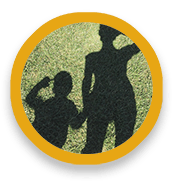SCIENCE EXPERIMENTS FOR KIDS
HOW TO DO SHADOW TRACING
Get your kids out of the dark with this fun activity exploring shadows
Here’s a riddle for you: What’s as big as an elephant, but weighs nothing at all? His shadow! Amuse your kids with that one while you herd (pun intended) them outside to make some shadows of their own.
This fun activity will show them how shadows are made and how they change in size and shape throughout the day. All you’ll need is some chalk and a flat area to cast their shadows on – oh, and some sun of course.
GATHER THIS:
- Chalk (Optional: 2 or more colors). Don’t have chalk? No problem! Put paper on the ground and use a pencil, pen, crayon, etc., to trace a shadow. Don’t have chalk or a paper and pencil? No problem! Trace a shadow in sand or dirt with your finger, or use rocks to outline the shadow.
- An object to cast a shadow, or a partner
- Optional: Tape measure or ruler
THEN DO THIS:
- Do this activity outside on a sunny day! No sun or can’t go outside? No problem! Use a light bulb, lamp, flashlight, etc. You could also try a fire flame – it just might be a little trickier to trace a shadow as the light may flicker and move around.
- Trace shadows on a hard, smooth surface like concrete, brick or wood.
- Trace your partner’s footprints on concrete.
- While standing in the footprints, trace your partner’s shadow. Write the time next to the shadow.
- Go on a shadow hunt and trace other shadows you both find.
- Return to your footprints 1 or 2 hours later and trace each other’s shadow again.
- Repeat steps 4–6 several times throughout the day. If you have 2 or more chalk colors, use a different color every time you trace your partner’s shadow.
- Optional: Use the tape measure or ruler to measure the length of your shadow from different times during the day and compare them.
ASK THIS:
- Is a shadow the same size and shape as the object being traced?
- How does the length, shape of the shadow change during the day?
- How does a shadow change when an object is closer to/farther from the light source?
- Does a clear (see-through) object cast a shadow? Try glasses or a piece of plastic.
- What color is a shadow?
- How does a shadow change if part, or all of it, is cast against a wall?
- How can you make a shadow look fuzzier/sharper?
- Try this activity at the same times of the day, but in a different season. How are the shadows the same or different?
WHAT IS HAPPENING?
A shadow is created when an object blocks light from a light source. The qualities of the shadow are determined by the type of light source and the position of the object blocking the light. An umbra is a type of shadow that is created when an object blocks all of the light. A penumbra is a type of shadow that is created when an object blocks only some of the light. This shadow may look gray or fuzzy compared to an umbra. A solar eclipse happens when the moon creates a shadow on Earth. A total eclipse is another way of saying the umbra shadow.
Shadows created by the sun change shape and length throughout the day because as the Earth rotates on an axis, the relative position of the sun changes in the sky. The size and direction of shadows created by the sun will also change seasonally anywhere on Earth except along the equator. This occurs because as Earth rotates on an axis to produce day and night, Earth is also orbiting the sun. The tilt of the planet combined with its position along its orbit will also change the relative position of the sun in the sky, and therefore the shadows.
WHAT THIS TEACHES:
Skills: Observations skills
Themes: Light, seasons
Join the CuriOdyssey Community
LOCATION
1651 Coyote Point Drive
San Mateo, CA 94401
Ohlone Land Acknowledgement
650-342-7755
[email protected]
CuriOdyssey is a 501(c)(3) nonprofit, Tax ID 94-1262434




